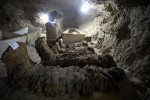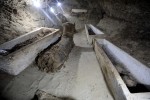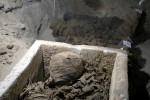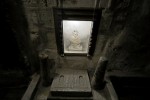 Archaeologists have discovered a tomb containing at least 17 mummies near Minya, Upper Egypt. The tomb was found more than 25 feet under the village of Tuna al-Gabal where a number of necropolises have been unearthed containing the mummified remains of animals. This one contained some animal coffins (baboons) too, but the stand-out finds are eight limestone and clay sarcophaguses holding well-preserved, linen-wrapped mummified human remains as well as stacked human remains without coffins. Archaeologists also found two papyri inscribed with Demotic script.
Archaeologists have discovered a tomb containing at least 17 mummies near Minya, Upper Egypt. The tomb was found more than 25 feet under the village of Tuna al-Gabal where a number of necropolises have been unearthed containing the mummified remains of animals. This one contained some animal coffins (baboons) too, but the stand-out finds are eight limestone and clay sarcophaguses holding well-preserved, linen-wrapped mummified human remains as well as stacked human remains without coffins. Archaeologists also found two papyri inscribed with Demotic script.
 The underground burial chamber was first spotted last year by Cairo University students using ground-penetrating radar, but they only knew it was a hollow space until the excavation this week discovered it was a cachette, an unmarked burial site where mummies were secreted to keep them safe from grave robbers. (The endeavor was of limited success; the site does appear to have been interfered with in antiquity or more recently.) The remains have yet to be radiocarbon dated. Researchers believe they may date to the Late Period — from around 600 B.C. until the conquest of Alexander in 332 B.C. — or possibly to the Greco-Roman period dating from Alexander’s conquest to around 300 A.D.
The underground burial chamber was first spotted last year by Cairo University students using ground-penetrating radar, but they only knew it was a hollow space until the excavation this week discovered it was a cachette, an unmarked burial site where mummies were secreted to keep them safe from grave robbers. (The endeavor was of limited success; the site does appear to have been interfered with in antiquity or more recently.) The remains have yet to be radiocarbon dated. Researchers believe they may date to the Late Period — from around 600 B.C. until the conquest of Alexander in 332 B.C. — or possibly to the Greco-Roman period dating from Alexander’s conquest to around 300 A.D.
 About 150 miles south of Cairo, Minya is the capital of the Minya Governorate, a province rich in archaeological sites including the city of Amarna, built by the Pharaoh Akhetaten and abandoned after his death; Hermopolis Magna, the cult center of the god Toth in ancient Egypt and an important Greco-Roman city where in some Christian traditions the Holy Family was said to have lived after their escape from Herod’s baby killers; Antinopolis, founded by the Emperor Hadrian in honor of his dearest companion Antinous whom he deified after his death by drowning in the Nile; and the Beni Hasan tombs of mongoose-on-a-leash fame.
About 150 miles south of Cairo, Minya is the capital of the Minya Governorate, a province rich in archaeological sites including the city of Amarna, built by the Pharaoh Akhetaten and abandoned after his death; Hermopolis Magna, the cult center of the god Toth in ancient Egypt and an important Greco-Roman city where in some Christian traditions the Holy Family was said to have lived after their escape from Herod’s baby killers; Antinopolis, founded by the Emperor Hadrian in honor of his dearest companion Antinous whom he deified after his death by drowning in the Nile; and the Beni Hasan tombs of mongoose-on-a-leash fame.
 With such a dense concentration of significant sites spanning the ages from the Old Kingdom to the modern era, you’d think a tomb with a bunch of mummies would hardly be headline news, but this one is unique. For one thing, it’s been a long time since any mummies were found in the area. Not since the discovery of the animal and bird necropolises between 1931 and 1954 have any kind of remains been discovered in Minya. Even more significantly, it’s the first human necropolis discovered in central Egypt to contain such a large number of mummies.
With such a dense concentration of significant sites spanning the ages from the Old Kingdom to the modern era, you’d think a tomb with a bunch of mummies would hardly be headline news, but this one is unique. For one thing, it’s been a long time since any mummies were found in the area. Not since the discovery of the animal and bird necropolises between 1931 and 1954 have any kind of remains been discovered in Minya. Even more significantly, it’s the first human necropolis discovered in central Egypt to contain such a large number of mummies.
Last but certainly not least:
Archeologists believe that it is the first time to unearth a burial tomb with that number of mummies for ordinary people and in catacombs style. Inside the catacomb, Khaled Anani, Egypt’s Minister of Antiquities referred to the gaps inside the catacombs saying “The more we drill the more we find.”
The Telegraph was given access to the tomb. Four wells of eight meters deep were unearthed, which lead to catacombs where mummies of men, women and children are laid in good shape.
In one chamber inside the tunnels, human bones and skulls are piled. Most of the mummies were laid in lines in both of its sides. While some them were left in plain stone and wooden sarcophagi, others were piled on top of each other.
 The well-preserved mummies inside the coffins were given expensive treatment, so it’s likely they were not just regular Joes off the street. Since Minya was known as a center for the worship of the god Toth, they could have been priests associated with his temple.
The well-preserved mummies inside the coffins were given expensive treatment, so it’s likely they were not just regular Joes off the street. Since Minya was known as a center for the worship of the god Toth, they could have been priests associated with his temple.
The excavation has only just begun, and archaeologists expect to find more of the catacomb and more human remains as they proceed. The papyri are being moved to the Grand Egyptian Museum for conservation.